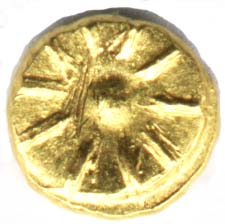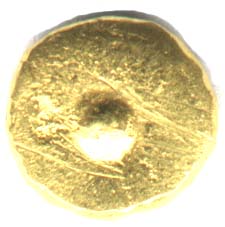

The prospect of owning Treasure has led many Lankans with excess money to invest fortunes in fake gold coins. The Pyramid scheme is not the only gold coin scam in town. Recent articles in the Sinhala media, report on a gang now in custody, who are claimed to have swindled millions from gullible public. For reasons I don't understand these reports have not appeared in the corresponding English media newspapers.
In early July 2006 I was contacted by a member of the Sri Lanka Numismatic Society, who visited me with a co-worker who said he had a friend that claimed to know a farmer who had found a Nidana (Treasure). They showed me three small coins they said had been determined to be 24kt gold.

| 
|
I agreed to investigate to ensure that IF this claim was genuine, the treasure was not melted for gold. I requested that a larger sample of about 100 coins to be made available for detailed study. I was first told that such a sample would be brought to Colombo, but then the contact was asked to bring cash and collect them from a location in Anuradhapura district. When he drove there he was told the hoard had been sold to someone else. The crooks had clearly had not wanted the items checked by anyone knowledgeable.

| 
|
An example gifted to me by a dealer, a gold plated silver replica of a medieval Lankan Pala ( Quarter Kahavanu ) type III with Jasmine flower and Chank. 13 mm in diameter 1.2 mm thick and 1.2 grams in weight. One needs to be an expert to identify this as a modern fake.
One is reminded of a comment in 1907 by John Still in his papers in the Journal of the Royal Asiatic Society Ceylon Branch, Vol 19 #58. On page 164 he puts a footnote to the word "genuine" I quote "How rare genuine specimens are I am inclined to think very few people thoroughly recognize. Gold "Lankesvaras" and "Vijaya Bahus' are turned out wholesale in Kandy now, and are so skillfully done that most of them are duly absorbed into collections. The improved manufacture of late is marked"
The dealers described to me the sequence of events, exactly as it was more recently published in articles in the Divayina (10th Aug) and Lankadeepa (13 Aug).
First a few sample coins made of gold are sent through brokers, to establish an interest. The hoard is offered at gold price or below, with a claim of much higher antiquity value. The seller requires buyer to visit remote site to obtain the hoard. A parcel is shown which appears to have gold colour coins like the sample coins. Some of those who have got caught to this trick have later found out the coins in hoard unlike the samples were either gold plated copper or silver coins. Sometimes even small pieces of scrap iron at bottom of parcel for weighed. The others who have got caught, may have put them in Bank vaults without checking and assume they own an invaluable nidana.
I was told of one case where the buyer was almost kidnapped and held to ransom, when he was taken on foot, deep into a forest. In another case the buyer had given seller, bundles of paper in which only the top and bottom Rs1000 notes where currency. Each trying to scam the other, didn't check what they were given. The seller having found that he had not got the cash he expected, phoned the Police and had the buyers arrested for possession of an Archaeological hoard. The Archaeological Department determined that the items were fake coins and not antiques and those arrested were released from custody.
The Antiquities Act, No 24 of 1998 (amending the 1940 Antiquities Ordinance) requires that any genuine discovery of Antiquities of significant value, to be reported within 7 days to the Director General of Archeology via the local peace officer and Government Agent. If the find is retained by the Archaeological Department, the finder is rewarded with the market value if found in his own property, or shared 50-50 with the owner of property in which the treasure was found.
So in Summary
Author maintains an educational website on 2300 years of Lankan coins at http://coins.lakdiva.org.lk/, and is Vice President of the Sri Lanka Numismatic Society.